外文翻译-SBR法及其研究进展
- 格式:doc
- 大小:411.00 KB
- 文档页数:30
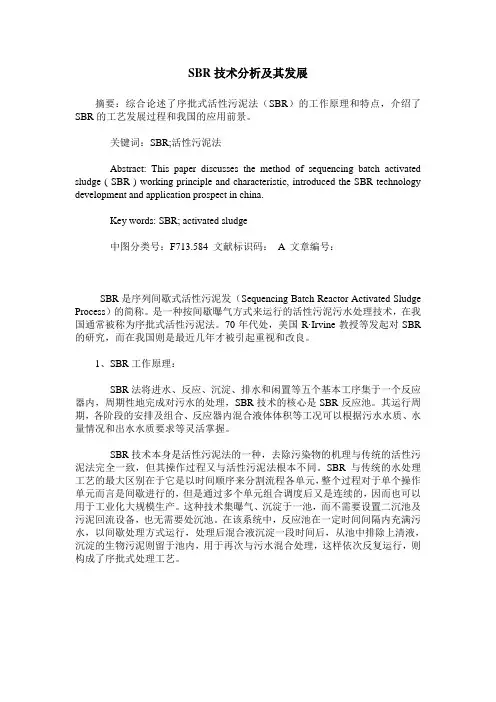
SBR技术分析及其发展摘要:综合论述了序批式活性污泥法(SBR)的工作原理和特点,介绍了SBR的工艺发展过程和我国的应用前景。
关键词:SBR;活性污泥法Abstract: This paper discusses the method of sequencing batch activated sludge ( SBR ) working principle and characteristic, introduced the SBR technology development and application prospect in china.Key words: SBR; activated sludge中图分类号:F713.584 文献标识码:A 文章编号:SBR是序列间歇式活性污泥发(Sequencing Batch Reactor Activated Sludge Process)的简称。
是一种按间歇曝气方式来运行的活性污泥污水处理技术,在我国通常被称为序批式活性污泥法。
70年代处,美国R·Irvine教授等发起对SBR 的研究,而在我国则是最近几年才被引起重视和改良。
1、SBR工作原理:SBR法将进水、反应、沉淀、排水和闲置等五个基本工序集于一个反应器内,周期性地完成对污水的处理,SBR技术的核心是SBR反应池。
其运行周期,各阶段的安排及组合、反应器内混合液体体积等工况可以根据污水水质、水量情况和出水水质要求等灵活掌握。
SBR技术本身是活性污泥法的一种,去除污染物的机理与传统的活性污泥法完全一致,但其操作过程又与活性污泥法根本不同。
SBR与传统的水处理工艺的最大区别在于它是以时间顺序来分割流程各单元,整个过程对于单个操作单元而言是间歇进行的,但是通过多个单元组合调度后又是连续的,因而也可以用于工业化大规模生产。
这种技术集曝气、沉淀于一池,而不需要设置二沉池及污泥回流设备,也无需要处沉池。
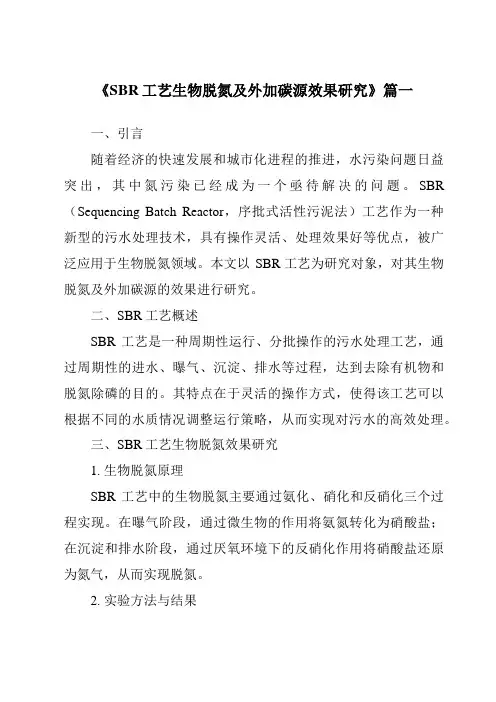
《SBR工艺生物脱氮及外加碳源效果研究》篇一一、引言随着经济的快速发展和城市化进程的推进,水污染问题日益突出,其中氮污染已经成为一个亟待解决的问题。
SBR (Sequencing Batch Reactor,序批式活性污泥法)工艺作为一种新型的污水处理技术,具有操作灵活、处理效果好等优点,被广泛应用于生物脱氮领域。
本文以SBR工艺为研究对象,对其生物脱氮及外加碳源的效果进行研究。
二、SBR工艺概述SBR工艺是一种周期性运行、分批操作的污水处理工艺,通过周期性的进水、曝气、沉淀、排水等过程,达到去除有机物和脱氮除磷的目的。
其特点在于灵活的操作方式,使得该工艺可以根据不同的水质情况调整运行策略,从而实现对污水的高效处理。
三、SBR工艺生物脱氮效果研究1. 生物脱氮原理SBR工艺中的生物脱氮主要通过氨化、硝化和反硝化三个过程实现。
在曝气阶段,通过微生物的作用将氨氮转化为硝酸盐;在沉淀和排水阶段,通过厌氧环境下的反硝化作用将硝酸盐还原为氮气,从而实现脱氮。
2. 实验方法与结果本研究采用SBR工艺处理模拟生活污水,通过调整曝气时间、沉淀时间等参数,研究生物脱氮的效果。
实验结果表明,在适宜的条件下,SBR工艺能够有效地去除污水中的氮元素,达到良好的脱氮效果。
四、外加碳源对SBR工艺脱氮效果的影响研究1. 外加碳源的作用外加碳源可以提高反硝化过程中的电子供体浓度,从而提高脱氮效率。
此外,适当的碳源还可以为微生物提供营养,促进其生长繁殖。
2. 实验方法与结果本研究通过向SBR反应器中添加不同种类的碳源(如甲醇、乙酸等),研究外加碳源对SBR工艺脱氮效果的影响。
实验结果表明,适当的外加碳源可以显著提高SBR工艺的脱氮效率。
其中,甲醇作为碳源时,脱氮效果最为显著。
此外,外加碳源还可以提高污泥的活性,有利于提高整个污水处理系统的稳定性。
五、结论本研究通过实验研究了SBR工艺的生物脱氮效果及外加碳源对脱氮效果的影响。
结果表明,SBR工艺具有较好的生物脱氮能力,外加碳源可以进一步提高脱氮效率。
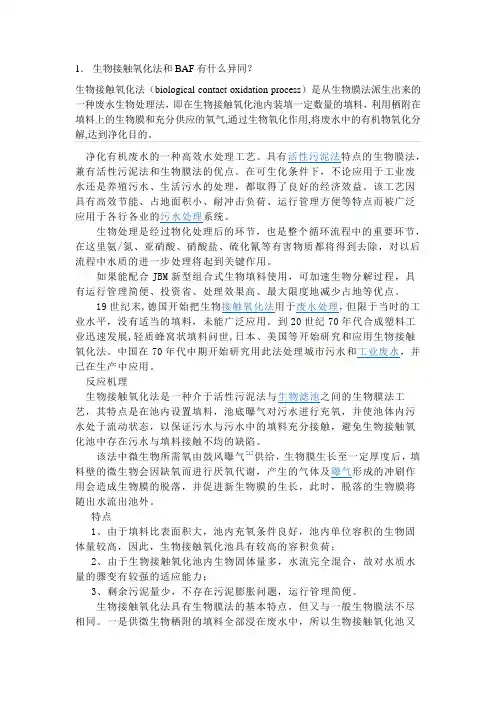
1.生物接触氧化法和BAF有什么异同?生物接触氧化法(biological contact oxidation process)是从生物膜法派生出来的一种废水生物处理法,即在生物接触氧化池内装填一定数量的填料,利用栖附在填料上的生物膜和充分供应的氧气,通过生物氧化作用,将废水中的有机物氧化分解,达到净化目的。
净化有机废水的一种高效水处理工艺。
具有活性污泥法特点的生物膜法,兼有活性污泥法和生物膜法的优点。
在可生化条件下,不论应用于工业废水还是养殖污水、生活污水的处理,都取得了良好的经济效益。
该工艺因具有高效节能、占地面积小、耐冲击负荷、运行管理方便等特点而被广泛应用于各行各业的污水处理系统。
生物处理是经过物化处理后的环节,也是整个循环流程中的重要环节,在这里氨/氮、亚硝酸、硝酸盐、硫化氰等有害物质都将得到去除,对以后流程中水质的进一步处理将起到关键作用。
如果能配合JBM新型组合式生物填料使用,可加速生物分解过程,具有运行管理简便、投资省、处理效果高、最大限度地减少占地等优点。
19世纪末,德国开始把生物接触氧化法用于废水处理,但限于当时的工业水平,没有适当的填料,未能广泛应用。
到20世纪70年代合成塑料工业迅速发展,轻质蜂窝状填料问世,日本、美国等开始研究和应用生物接触氧化法。
中国在70年代中期开始研究用此法处理城市污水和工业废水,并已在生产中应用。
反应机理生物接触氧化法是一种介于活性污泥法与生物滤池之间的生物膜法工艺,其特点是在池内设置填料,池底曝气对污水进行充氧,并使池体内污水处于流动状态,以保证污水与污水中的填料充分接触,避免生物接触氧化池中存在污水与填料接触不均的缺陷。
该法中微生物所需氧由鼓风曝气[1]供给,生物膜生长至一定厚度后,填料壁的微生物会因缺氧而进行厌氧代谢,产生的气体及曝气形成的冲刷作用会造成生物膜的脱落,并促进新生物膜的生长,此时,脱落的生物膜将随出水流出池外。
特点1、由于填料比表面积大,池内充氧条件良好,池内单位容积的生物固体量较高,因此,生物接触氧化池具有较高的容积负荷;2、由于生物接触氧化池内生物固体量多,水流完全混合,故对水质水量的骤变有较强的适应能力;3、剩余污泥量少,不存在污泥膨胀问题,运行管理简便。
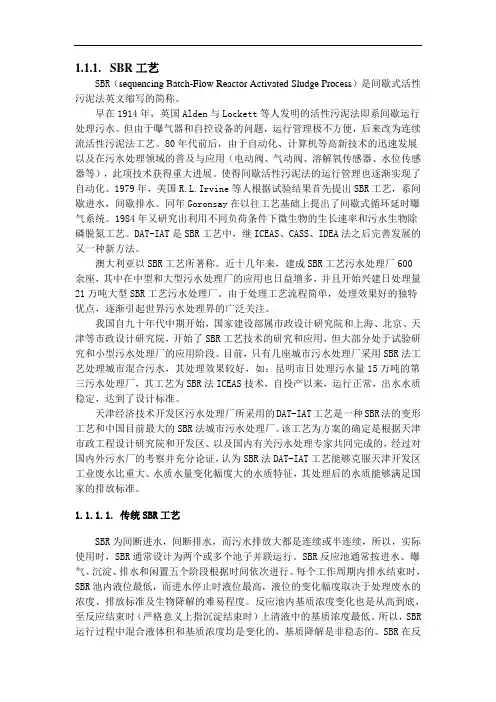
1.1.1.SBR工艺SBR( )是间歇式活性污泥法英文缩写的简称。
早在1914年,英国Alden与Lockett等人发明的活性污泥法即系间歇运行处理污水。
但由于曝气器和自控设备的问题,运行管理极不方便,后来改为连续流活性污泥法工艺。
80年代前后,由于自动化、计算机等高新技术的迅速发展以及在污水处理领域的普及与应用(电动阀、气动阀、溶解氧传感器、水位传感器等),此项技术获得重大进展。
使得间歇活性污泥法的运行管理也逐渐实现了自动化。
1979年,美国R.L.Irvine等人根据试验结果首先提出SBR工艺,系间歇进水,间歇排水。
同年Goronsay在以往工艺基础上提出了间歇式循环延时曝气系统。
1984年又研究出利用不同负荷条件下微生物的生长速率和污水生物除磷脱氮工艺。
DAT-IAT是SBR工艺中,继ICEAS、CASS、IDEA法之后完善发展的又一种新方法。
澳大利亚以SBR工艺所著称。
近十几年来,建成SBR工艺污水处理厂600余座,其中在中型和大型污水处理厂的应用也日益增多,并且开始兴建日处理量21万吨大型SBR工艺污水处理厂。
由于处理工艺流程简单,处理效果好的独特优点,逐渐引起世界污水处理界的广泛关注。
我国自九十年代中期开始,国家建设部属市政设计研究院和上海、北京、天津等市政设计研究院,开始了SBR工艺技术的研究和应用,但大部分处于试验研究和小型污水处理厂的应用阶段。
目前,只有几座城市污水处理厂采用SBR法工艺处理城市混合污水,其处理效果较好,如:昆明市日处理污水量15万吨的第三污水处理厂,其工艺为SBR法ICEAS技术,自投产以来,运行正常,出水水质稳定,达到了设计标准。
天津经济技术开发区污水处理厂所采用的DAT-IAT工艺是一种SBR法的变形工艺和中国目前最大的SBR法城市污水处理厂。
该工艺为方案的确定是根据天津市政工程设计研究院和开发区、以及国内有关污水处理专家共同完成的,经过对国内外污水厂的考察并充分论证,认为SBR法DAT-IAT工艺能够克服天津开发区工业废水比重大、水质水量变化幅度大的水质特征,其处理后的水质能够满足国家的排放标准。
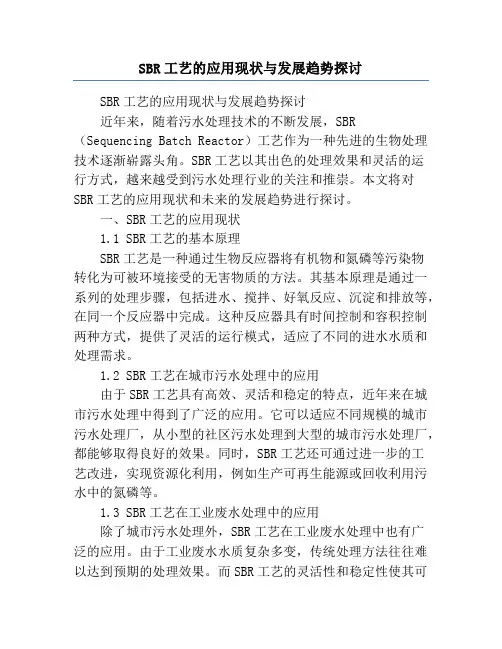
SBR工艺的应用现状与发展趋势探讨SBR工艺的应用现状与发展趋势探讨近年来,随着污水处理技术的不断发展,SBR (Sequencing Batch Reactor)工艺作为一种先进的生物处理技术逐渐崭露头角。
SBR工艺以其出色的处理效果和灵活的运行方式,越来越受到污水处理行业的关注和推崇。
本文将对SBR工艺的应用现状和未来的发展趋势进行探讨。
一、SBR工艺的应用现状1.1 SBR工艺的基本原理SBR工艺是一种通过生物反应器将有机物和氮磷等污染物转化为可被环境接受的无害物质的方法。
其基本原理是通过一系列的处理步骤,包括进水、搅拌、好氧反应、沉淀和排放等,在同一个反应器中完成。
这种反应器具有时间控制和容积控制两种方式,提供了灵活的运行模式,适应了不同的进水水质和处理需求。
1.2 SBR工艺在城市污水处理中的应用由于SBR工艺具有高效、灵活和稳定的特点,近年来在城市污水处理中得到了广泛的应用。
它可以适应不同规模的城市污水处理厂,从小型的社区污水处理到大型的城市污水处理厂,都能够取得良好的效果。
同时,SBR工艺还可通过进一步的工艺改进,实现资源化利用,例如生产可再生能源或回收利用污水中的氮磷等。
1.3 SBR工艺在工业废水处理中的应用除了城市污水处理外,SBR工艺在工业废水处理中也有广泛的应用。
由于工业废水水质复杂多变,传统处理方法往往难以达到预期的处理效果。
而SBR工艺的灵活性和稳定性使其可以适应不同种类和水质的工业废水处理。
近年来,SBR工艺在制药、化工、食品等行业的废水处理中得到了广泛应用,并取得了良好的效果。
二、SBR工艺的发展趋势2.1 高效能与节能技术的应用近年来,SBR工艺在高强度、高浓度的有机废水处理中取得了一定的进展。
新型的生物载体材料、微生物种类优化以及一些高效能、节能的反应器设计需要更多的研究和应用。
例如,利用好氧-厌氧耦合的方式进一步提高有机物去除率,在能耗的减少和处理效果的提高方面具有较大的潜力。
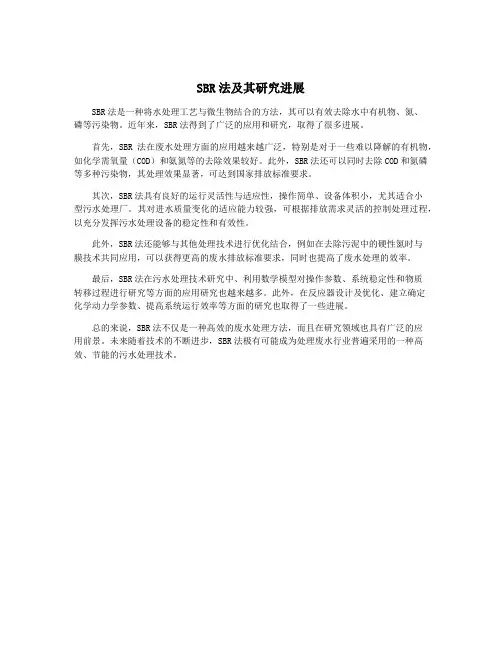
SBR法及其研究进展
SBR法是一种将水处理工艺与微生物结合的方法,其可以有效去除水中有机物、氮、
磷等污染物。
近年来,SBR法得到了广泛的应用和研究,取得了很多进展。
首先,SBR法在废水处理方面的应用越来越广泛,特别是对于一些难以降解的有机物,如化学需氧量(COD)和氨氮等的去除效果较好。
此外,SBR法还可以同时去除COD和氮磷等多种污染物,其处理效果显著,可达到国家排放标准要求。
其次,SBR法具有良好的运行灵活性与适应性,操作简单、设备体积小,尤其适合小
型污水处理厂。
其对进水质量变化的适应能力较强,可根据排放需求灵活的控制处理过程,以充分发挥污水处理设备的稳定性和有效性。
此外,SBR法还能够与其他处理技术进行优化结合,例如在去除污泥中的硬性氮时与
膜技术共同应用,可以获得更高的废水排放标准要求,同时也提高了废水处理的效率。
最后,SBR法在污水处理技术研究中、利用数学模型对操作参数、系统稳定性和物质
转移过程进行研究等方面的应用研究也越来越多。
此外,在反应器设计及优化、建立确定
化学动力学参数、提高系统运行效率等方面的研究也取得了一些进展。
总的来说,SBR法不仅是一种高效的废水处理方法,而且在研究领域也具有广泛的应
用前景。
未来随着技术的不断进步,SBR法极有可能成为处理废水行业普遍采用的一种高效、节能的污水处理技术。
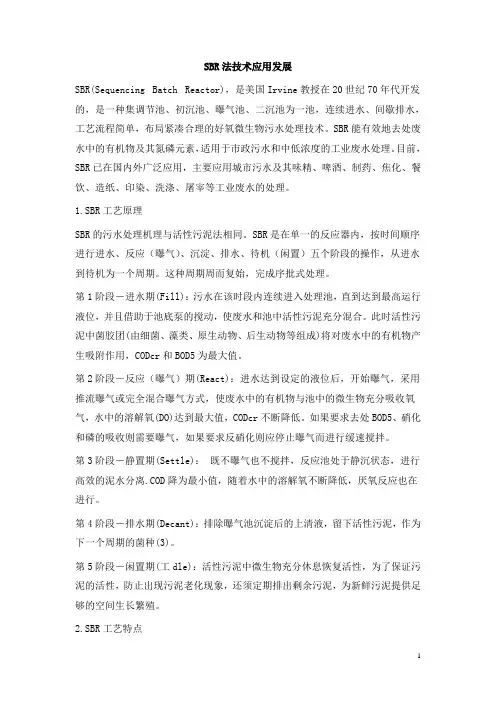
SBR法技术应用发展SBR(Sequencing Batch Reactor),是美国Irvine教授在20世纪70年代开发的,是一种集调节池、初沉池、曝气池、二沉池为一池,连续进水、间歇排水,工艺流程简单,布局紧凑合理的好氧微生物污水处理技术。
SBR能有效地去处废水中的有机物及其氮磷元素,适用于市政污水和中低浓度的工业废水处理。
目前,SBR已在国内外广泛应用,主要应用城市污水及其味精、啤酒、制药、焦化、餐饮、造纸、印染、洗涤、屠宰等工业废水的处理。
1.SBR工艺原理SBR的污水处理机理与活性污泥法相同。
SBR是在单一的反应器内,按时间顺序进行进水、反应(曝气)、沉淀、排水、待机(闲置)五个阶段的操作,从进水到待机为一个周期。
这种周期周而复始,完成序批式处理。
第1阶段-进水期(Fill):污水在该时段内连续进入处理池,直到达到最高运行液位,并且借助于池底泵的搅动,使废水和池中活性污泥充分混合。
此时活性污泥中菌胶团(由细菌、藻类、原生动物、后生动物等组成)将对废水中的有机物产生吸附作用,CODcr和BOD5为最大值。
第2阶段-反应(曝气)期(React):进水达到设定的液位后,开始曝气,采用推流曝气或完全混合曝气方式,使废水中的有机物与池中的微生物充分吸收氧气,水中的溶解氧(DO)达到最大值,CODcr不断降低。
如果要求去处BOD5、硝化和磷的吸收则需要曝气,如果要求反硝化则应停止曝气而进行缓速搅拌。
第3阶段-静置期(Settle):既不曝气也不搅拌,反应池处于静沉状态,进行高效的泥水分离.COD降为最小值,随着水中的溶解氧不断降低,厌氧反应也在进行。
第4阶段-排水期(Decant):排除曝气池沉淀后的上清液,留下活性污泥,作为下一个周期的菌种(3)。
第5阶段-闲置期(工dle):活性污泥中微生物充分休息恢复活性,为了保证污泥的活性,防止出现污泥老化现象,还须定期排出剩余污泥,为新鲜污泥提供足够的空间生长繁殖。
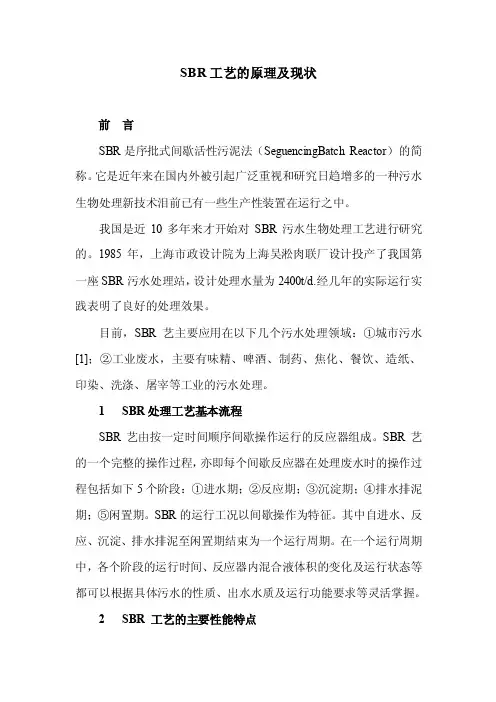
SBR工艺的原理及现状前言SBR是序批式间歇活性污泥法(SeguencingBatch Reactor)的简称。
它是近年来在国内外被引起广泛重视和研究日趋增多的一种污水生物处理新技术泪前已有一些生产性装置在运行之中。
我国是近10多年来才开始对SBR污水生物处理工艺进行研究的。
1985年,上海市政设计院为上海吴淞肉联厂设计投产了我国第一座SBR污水处理站,设计处理水量为2400t/d.经几年的实际运行实践表明了良好的处理效果。
目前,SBR艺主要应用在以下几个污水处理领域:①城市污水[1];②工业废水,主要有味精、啤酒、制药、焦化、餐饮、造纸、印染、洗涤、屠宰等工业的污水处理。
1SBR处理工艺基本流程SBR艺由按一定时间顺序间歇操作运行的反应器组成。
SBR艺的一个完整的操作过程,亦即每个间歇反应器在处理废水时的操作过程包括如下5个阶段:①进水期;②反应期;③沉淀期;④排水排泥期;⑤闲置期。
SBR的运行工况以间歇操作为特征。
其中自进水、反应、沉淀、排水排泥至闲置期结束为一个运行周期。
在一个运行周期中,各个阶段的运行时间、反应器内混合液体积的变化及运行状态等都可以根据具体污水的性质、出水水质及运行功能要求等灵活掌握。
2 SBR 工艺的主要性能特点SBR作为废水处理方法具有下述主要特点:在空间上完全混合,时间上完全推流式,反应速度高,为获得同样的处理效率SBR法的反应池理论明显小于连续式的体积,且池越多,SBR的总体积越小。
工艺流程简单,构筑物少,占地省,造价低,设备费。
运行管理费用低。
静止沉淀,分离效果好,出水水质高。
运行方式灵活,可生成多种工艺路线。
同一反应器仅通过改变运行工艺参数就可以处理不同性质的废水。
由于进水结束后,原水与反应器隔离,进水水质水量的变化对反应器不再有任何影响,因此工艺的耐冲击负荷能力高。
间歇进水、排放以及每次进水只占反应器的2/3右,其稀释作用进一步提高了工艺对进水冲击负荷的耐受能力。
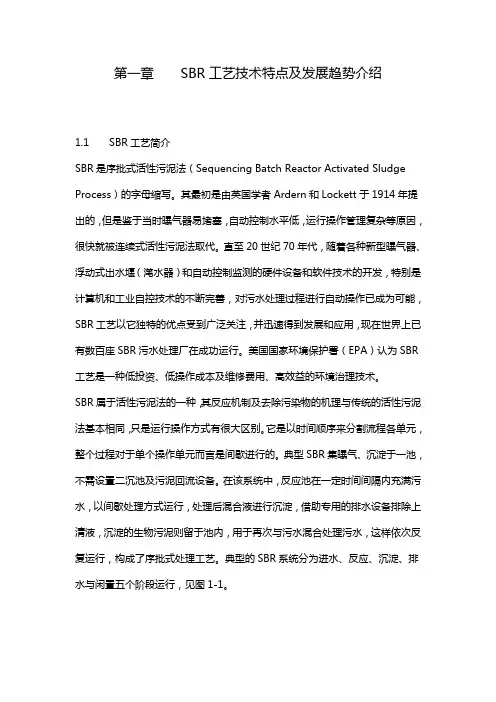
第一章SBR工艺技术特点及发展趋势介绍1.1SBR工艺简介SBR是序批式活性污泥法(Sequencing Batch Reactor Activated Sludge Process)的字母缩写。
其最初是由英国学者Ardern和Lockett于1914年提出的,但是鉴于当时曝气器易堵塞,自动控制水平低,运行操作管理复杂等原因,很快就被连续式活性污泥法取代。
直至20世纪70年代,随着各种新型曝气器、浮动式出水堰(滗水器)和自动控制监测的硬件设备和软件技术的开发,特别是计算机和工业自控技术的不断完善,对污水处理过程进行自动操作已成为可能,SBR工艺以它独特的优点受到广泛关注,并迅速得到发展和应用,现在世界上已有数百座SBR污水处理厂在成功运行。
美国国家环境保护署(EPA)认为SBR工艺是一种低投资、低操作成本及维修费用、高效益的环境治理技术。
SBR属于活性污泥法的一种,其反应机制及去除污染物的机理与传统的活性污泥法基本相同,只是运行操作方式有很大区别。
它是以时间顺序来分割流程各单元,整个过程对于单个操作单元而言是间歇进行的。
典型SBR集曝气、沉淀于一池,不需设置二沉池及污泥回流设备。
在该系统中,反应池在一定时间间隔内充满污水,以间歇处理方式运行,处理后混合液进行沉淀,借助专用的排水设备排除上清液,沉淀的生物污泥则留于池内,用于再次与污水混合处理污水,这样依次反复运行,构成了序批式处理工艺。
典型的SBR系统分为进水、反应、沉淀、排水与闲置五个阶段运行,见图1-1。
图1-1SBR基本运行模式SBR工艺具有以下几个主要的优点:1.处理构筑物很少,一个SBR反应器集曝气、沉淀于一体,省去了初沉池、二沉池和回流污泥泵房。
因此,大大节约了处理构筑物的占地面积、构筑物间的连接管道及流体输送设备,一般可降低工程总投资的10%~20%。
2.由于其间歇进水,时间长短、水量多少均可调节,因此对水量水质的变化具有较强的适应性,不需另设调节池。
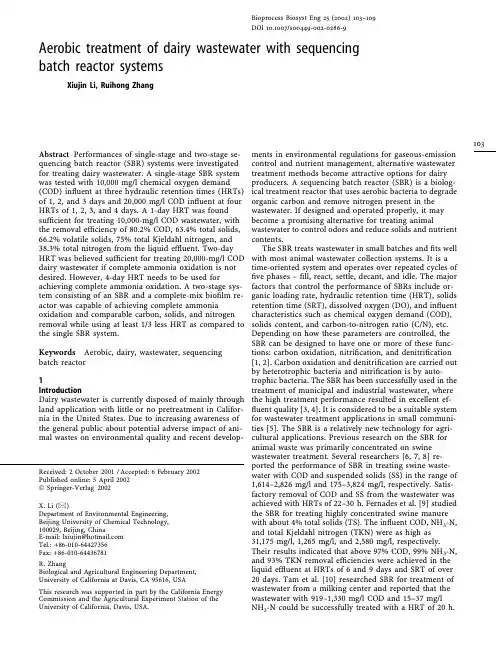
Aerobic treatment of dairy wastewater with sequencing batch reactor systemsXiujin Li,Ruihong ZhangAbstract Performances of single-stage and two-stage se-quencing batch reactor(SBR)systems were investigated for treating dairy wastewater.A single-stage SBR system was tested with10,000mg/l chemical oxygen demand (COD)influent at three hydraulic retention times(HRTs) of1,2,and3days and20,000mg/l COD influent at four HRTs of1,2,3,and4days.A1-day HRT was foundsufficient for treating10,000-mg/l COD wastewater,with the removal efficiency of80.2%COD,63.4%total solids, 66.2%volatile solids,75%total Kjeldahl nitrogen,and 38.3%total nitrogen from the liquid effluent.Two-day HRT was believed sufficient for treating20,000-mg/l COD dairy wastewater if complete ammonia oxidation is not desired.However,4-day HRT needs to be used for achieving complete ammonia oxidation.A two-stage sys-tem consisting of an SBR and a complete-mix biofilm re-actor was capable of achieving complete ammonia oxidation and comparable carbon,solids,and nitrogen removal while using at least1/3less HRT as compared to the single SBR system.Keywords Aerobic,dairy,wastewater,sequencing batch reactor1IntroductionDairy wastewater is currently disposed of mainly through land application with little or no pretreatment in Califor-nia in the United States.Due to increasing awareness of the general public about potential adverse impact of ani-mal wastes on environmental quality and recent develop-ments in environmental regulations for gaseous-emission control and nutrient management,alternative wastewater treatment methods become attractive options for dairy producers.A sequencing batch reactor(SBR)is a biolog-ical treatment reactor that uses aerobic bacteria to degrade organic carbon and remove nitrogen present in the wastewater.If designed and operated properly,it maybecome a promising alternative for treating animal wastewater to control odors and reduce solids and nutrient contents.The SBR treats wastewater in small batches andfits wellwith most animal wastewater collection systems.It is atime-oriented system and operates over repeated cycles offive phases–fill,react,settle,decant,and idle.The major factors that control the performance of SBRs include or-ganic loading rate,hydraulic retention time(HRT),solids retention time(SRT),dissolved oxygen(DO),and influent characteristics such as chemical oxygen demand(COD),solids content,and carbon-to-nitrogen ratio(C/N),etc. Depending on how these parameters are controlled,theSBR can be designed to have one or more of these func-tions:carbon oxidation,nitrification,and denitrification[1,2].Carbon oxidation and denitrification are carried outby heterotrophic bacteria and nitrification is by auto-trophic bacteria.The SBR has been successfully used in the treatment of municipal and industrial wastewater,wherethe high treatment performance resulted in excellent ef-fluent quality[3,4].It is considered to be a suitable systemfor wastewater treatment applications in small communi-ties[5].The SBR is a relatively new technology for agri-cultural applications.Previous research on the SBR foranimal waste was primarily concentrated on swine wastewater treatment.Several researchers[6,7,8]re-ported the performance of SBR in treating swine waste-water with COD and suspended solids(SS)in the range of1,614–2,826mg/l and175–3,824mg/l,respectively.Satis-factory removal of COD and SS from the wastewater was achieved with HRTs of22–30h.Fernades et al.[9]studiedthe SBR for treating highly concentrated swine manurewith about4%total solids(TS).The influent COD,NH3-N,and total Kjeldahl nitrogen(TKN)were as high as31,175mg/l,1,265mg/l,and2,580mg/l,respectively.Their results indicated that above97%COD,99%NH3-N,and93%TKN removal efficiencies were achieved in theliquid effluent at HRTs of6and9days and SRT of over20days.Tam et al.[10]researched SBR for treatment of wastewater from a milking center and reported that the wastewater with919–1,330mg/l COD and15–37mg/lNH3-N could be successfully treated with a HRT of20h. Bioprocess Biosyst Eng25(2002)103–109DOI10.1007/s00449-002-0286-9103Received:2October2001/Accepted:6February2002 Published online:5April2002ÓSpringer-Verlag2002X.Li(&)Department of Environmental Engineering,Beijing University of Chemical Technology,100029,Beijing,ChinaE-mail:lxiujin@Tel.:+86-010-********Fax:+86-010-********R.ZhangBiological and Agricultural Engineering Department, University of California at Davis,CA95616,USAThis research was supported in part by the California Energy Commission and the Agricultural Experiment Station of the University of California,Davis,USA.Studies on the SBR for treating dairy manure are not well documented in the literature.Previous researchfindings about the SBR for treatment of swine manure and other types of wastewater provide valuable references for the treatment of dairy wastewater.However,due to the dif-ferences in the characteristics of dairy wastewater from other types of wastewater,research is needed to develop design and operational guidelines for the SBR in treating dairy wastewater of various characteristics.The objectives of this study are to investigate the effects of wastewater characteristics,HRT,SRT,and organic loading rate on the performance of the SBR system in treating dairy wastewater for carbon and solids removal and nitrogen conversion,and develop design and opera-tional guidelines for the SBR system in single-and mul-tiple-stage configurations.2Materials and methods2.1Dairy manure collection and preparationDairy manure was collected on the Dairy Research Farm of the University of California at Davis.Due to runoff of urine on the feedlot,the collected manure was mainly feces and contained a relatively low content of ammonia nitro-gen.The manure was slurried with addition of water and then screened twice with two sieves with openings of4·4 and2·2mm,respectively,to remove large particles.The screened manure was transported immediately to the laboratory and stored in a freezer at–20°C until use.The TS and COD of the screened manure were30,000–40,000mg/l and35,000–50,000mg/l,respectively.When needed,the stored manure was thawed and then diluted with tap water to obtain a desired COD concentration.Due to relatively low ammonia content of the raw manure as compared to typical levels in the manure collected on dairy farms,urea was added to increase the NH3-N in the prepared manure from100–125mg/l to500–550mg/l.The prepared manure was then put into a50-l feeding tank housed in a refrigerator at4°C for daily use.The feeding tank had an agitator to mix the wastewater during the feeding of the reactors.2.2Experimental setup and operationBoth single-stage and two-stage treatment systems were tested.The single-stage SBR system consisted of an SBR and a solids-settling tank in series.The wastewater wasfirst fed into the SBR for treatment and the effluent of the SBR, including both sludge and liquid,was then discharged into a settling tank,where liquid was separated from sludge by gravity settling and characterized as liquid effluent of the system.The two-stage system consisted of an SBR(first-stage reactor),a solids-settling tank,and a complete-mix biofilm reactor(CMBR)(second-stage reactor)connected in series.The liquid effluent obtained from the solids-set-tling tank was used as influent of CMBR and further treated in the CMBR for achieving complete nitrification.The two-stage SBR-CMBR system is shown in Fig.1.Each system was fed and decanted twice a day for12h in each treatment cycle.All the peristaltic pumps used for feeding and decanting were operated automatically with a digital time controller.The time sequence for different operations during each treatment cycle of the SBR was1–3minfill,11h and4–8min react,40min settle,1–3min decant,and10min idle.The CMBR was operated as a complete-mix reactor and had long SRT provided by the attached growth on the polyethylene pellets placed in the reactor.The plastic pellets had light density(920kg/ m3)and were keptfluidized with the airflow.Each pellet was10mm in diameter and10mm in height,with a cross inside the cylinder and longitudinalfins on the outside, providing a large surface area for bacterial attachment. Thefilling volume of the pellets in total occupied ap-proximately18%of liquid volume(3l)in the reactor.The SBR and CMBR reactors were made from trans-parent acrylic and had a total volume of6l each,with51cm height and12cm diameter.During testing,the liquid vol-ume of each reactor was3l.Each reactor was aerated using pressurized air at a controlledflow rate.In order to mini-mize the water evaporation in the reactor,the air was hu-midified by traveling through water contained in a15-l jar prior to entering the reactor.The air was evenly distributed into the wastewater through four air stone diffusers in-stalled near the bottom of the reactor.All the reactors were initially seeded with the activated sludge obtained from the UC Davis Wastewater Treatment Plant and allowed to ac-climate for about2months before formal experiments were started.It normally took about4weeks for each SBR re-actor to reach a steady state when a new operating condi-tion was introduced.The steady state was defined to be a state when the weekly variations of effluent COD,TS,NH3-N,and pH were less than5%.These parameters were monitored twice a week.The CMBR had been fully accli-mated with dilute dairy wastewater for about6months and had nitrification bacteria well established before being connected with the SBR.The mixed liquor suspended solids (MLSS)in the CMBR was about10,000mg/l,which was calculated from both suspended growth and attached growth solids.In order to determine the ammonia emission from SBR due to aeration,ammonia in the exiting air of SBR was collected by absorbing it in0.3N boric acid solution for 24h under each testing condition.2.3Experimental plan and system performance evaluation The experiment was carried out in two phases.Thefirst phase was for studying the effects of influent characteris-tics,HRT,and corresponding SRT and loading rate on the performance of the single-stage SBR system.The second phase was to evaluate the performance of a two-stage SBR-CMBR system.The two systems were then compared in terms of carbon and solids removal and nitrogen conver-sion efficiencies.With the single-stage SBR system,three HRTs(1,2and 3days)were tested for wastewater of10,000mg/l COD and four HRTs(1,2,3and4days)for wastewater of20,000mg/l COD.For the wastewater of10,000mg/l COD, the corresponding loading rate and SRT for the three HRTs were10,5,and3.3g COD/l/day and8,12,andBioprocess Biosyst Eng25(2002) 10415days,respectively.For the wastewater of 20,000mg/l COD,the corresponding loading rate and SRT for the four HRTs were 20,10,6.7,and 5g COD/l/day and 1.5,3,4,and 6days,respectively.With the two-stage SBR system,2days was used first as the system HRT,with 1day for the first-stage and 1day for the second-stage for both in flu-ents,and then 2.5days was used with 2days for the first stage and 0.5days for the second stage.An air flow rate of 4l/min was applied for all runs,which was able to main-tain dissolved oxygen (DO)in the SBR and CMBR above 3mg/l.The performance of the treatment systems was evalu-ated in terms of carbon and solids removal and nitrogen conversion ef ficiencies.The parameters analyzed included TS,volatile solids (VS),COD,SCOD (soluble COD),TKN,NH 3-N,NO 2-N,and NO 3-N.Two kinds of removal/con-version ef ficiencies were used to interpret the results for carbon and solids removal and nitrogen oxidation.One ef ficiency,E t ,is based on the removal from total ef fluent (including both sludge and liquid ef fluent generated),re-flecting the removal ef ficiency through biological process alone.The other ef ficiency,E l ,was based on the removal from liquid ef fluent,i.e.,supernatant,representing the removal ef ficiency through both biological process and sludge separation.For the single-stage SBR system,the total ef fluent was the ef fluent from the SBR and the liquid ef fluent was the supernatant decanted from the solids settling tank.For the two-stage SBR-CMBR system,the total ef fluent was the combination of sludge from the settling tank and the final ef fluent from CMBR,and the liquid ef fluent was the liquid ef fluent of CMBR.Most of previous research only reports removal ef ficiency from liquid ef fluent (E l ).Actually,E l does not re flect the real capability of a system for removing various constituents from wastewater,because part of these constituents are contained in the sludge that is separated from the liquid ef fluent and discharged as a separate sludge stream.Therefore,E t needs to be used in order to assess the real capability of a system for removing various constituents from wastewater.2.4Sampling and analytical methodsAfter each reactor reached steady state under testing conditions,samples were taken from the in fluent,mixed liquor,total ef fluent,and liquid ef fluent of the reactor three times a week (every other day)for analyses of COD,SCOD,TS,VS,NH 3-N,NO 2-N,NO 3-N,and TKN.The re-moval ef ficiencies,E l and E t ,were calculated based on the data from in fluent,liquid ef fluent,and total ef fluent of the systems.The separation of sludge and liquid in the total ef fluent of the SBR was performed by settling the ef fluent in a 1-l graduated cylinder for 2h and then decanting the liquid fraction above the sludge-liquid interface line.The COD,SCOD,TS,VS,and TKN were measured according to APHA standard methods [11].The COD measured in this study was COD Cr .The pH was measured with an Accumet pH meter (Fisher Scienti fic,Pittsburgh,Pa.).The NH 3-N was measured with a gas-sensing elec-trode and the pH meter.The DO in the reactors wasmonitored on a daily basis with a DO meter (YSI Mode158,Fisher Scienti fic,Pittsburgh,Pa.).The NO 2-N was analyzed with the HACH method,using a DR/2000spectropho-tometer [12].The NO 3-N was measured with a diffusion –conductivity analyzer [13].3Results and discussion3.1Performance of the single-stage SBR system3.1.1Removal of carbon and solidsThe performance data of the SBR for 10,000mg/l COD in fluent COD of 10,000are shown in Table 1.With the increase of HRT from 1to 3days,the COD,SCOD,TS,and VS in the liquid ef fluent became lower,yielding better ef fluent quality due to increased biological conversion and improved sludge settleability,as indicated by the increased removal ef ficiencies (E l and E t ).However,there wasnoboratory setup for a two-stage SBR-CMBR system for dairy wastewater treatmentX.Li,R.Zhang:Aerobic treatment of dairy wastewater with sequencing batch reactor systems105signi ficant difference in terms of carbon and solids rem-ovals and liquid ef fluent quality for the three HRTs.For example,the increase of COD and TS removal ef ficiency E l was 5.1%and 0.3%,and E t was 5.7%and 2.0%,respec-tively,when HRT increased from 1to 3days.Therefore,1-day HRT was believed to be suf ficient for treating the dairy wastewater with 10,000mg/l COD for its satisfactory removal ef ficiency and relatively short HRT.At 1-day HRT,the removal ef ficiency from the liquid ef fluent (E l )was 80.2%for COD,63.4%for TS,and 66.2%for VS.These removals were due to both biological conversion in the SBR and sludge separation in the solids-settling tank.The removal due to biological conversion alone in the SBR,as measured by E t ,was 45.0%for COD,21.4%for TS,and 34.2%for VS.E t was signi ficantly greater than E l ,sug-gesting that the sludge separation after SBR treatment is necessary for achieving signi ficant carbon and solids re-moval from the dairy wastewater.It was found that aerobic treatment greatly enhanced the flocculation and settlea-bility of the solids in the wastewater.Good settleability of sludge was important for achieving high carbon and solids removal ef ficiency.The performance data of the SBR for 20,000mg/l COD in fluent are shown in Table 2.The 1-day HRT was tested first.It was found that it was impossible to control the SRT at a desired level due to fast solids buildup in the reactor and poor solids settleability.When the HRT was increased to 2days,there was signi ficant improvement in the ef fluent quality and increase of removal ef ficiencies.However,when the HRT was further increased to 3days,the changes in the ef fluent quality,COD,and solids removals were not signif-icant.Therefore,2-day HRT was considered enough for COD and solids removal for 20,000mg/l COD in fluent due to its relatively short retention time and high removal ef fi-ciency.At 2-day HRT,the removal ef ficiency E l of COD,SCOD,TS,and VS was 85.7%,67.1%,71.0%,and 70.6%,respectively,and E t was 35.9%,67.1%,22.8%,and 25.6%,respectively.The 4-day HRT was tested for achieving com-plete ammonia conversion.Since ammonia was not com-pletely converted at 2-day and 3-day HRT,longer HRT was needed when complete nitri fication was desired.This will be further discussed in the following nitrogen removal section.The sludge separated from the ef fluent of the SBR contained 4.1–5.9%TS.The lower in fluent COD(10,000mg/l)resulted in better sludge settleability than the higher in fluent COD (20,000mg/l).The sludge volume as the fraction of total ef fluent volume was 5–6%and 13–16%for the lower and higher levels of in fluent COD,respectively.The sludge was composed of not-degraded solids in the wastewater and newly formed bacterial cells.It can be further processed into organic soil amendment through dewatering and composting.Table 1.Ef fluent quality and treatment ef ficiencies of SBR for 10,000mg/l COD in fluentParametersIn fluent (mg/l)1-day HRT 2-day HRT3-day HRT Liquid ef fluent Total ef fluent E l (%)E t (%)Liquid ef fluent Total ef fluent E l (%)E t (%)Liquid ef fluent Total ef fluent E l (%)E t (%)(mg/l)(mg/l)(mg/l)(mg/l)(mg/l)(mg/l)COD 10,0001,9806,50080.245.01,5805,13084.248.71,4704,93085.350.7SCOD 2,9141,4571,45750.050.01,4511,45150.250.21,4281,42851.051.0TS 6,6562,4365,23263.421.42,4765,07962.823.72,4165,09863.723.4VS 5,1081,7243,36166.234.21,5323,24970.036.41,4003,16772.638.0TKN 7801953657553.218535476.354.616533878.856.7TN 78048160738.322.248059838.523.447459639.223.6NH 3-N 51012012076.576.510510579.479.4707086.386.3NO 3-N 0375545NO 2-N 024*******pH8.16.86.76.7Table 2.Ef fluent quality and treatment ef ficiencies of SBR for 20,000mg/l COD in fluentPara-meters In fluent (mg/l)1-day HRT 2-day HRT 3-day HRT 4-day HRTLiquid ef fluent Total ef fluent E l (%)E t (%)Liquid ef fluent Total ef fluent E l (%)E t (%)Liquid ef fluent Total ef fluent E l (%)E t (%)Liquid ef fluent Total ef fluent E l (%)E t (%)(mg/l)(mg/l)(mg/l)(mg/l)(mg/l)(mg/l)(mg/l)(mg/l)COD 20,0004,30013,92078.530.42,87012,82085.735.92,66012,32086.738.4167010,90091.743.3SCOD 6,6603,1973,19752.052.02,1902,19067.167.12,0052,00569.969.912151,21581.881.8TS 12,4424,36710,11564.918.73,6129,60571.022.83,4989,58071.923.033509,19573.124.3VS 10,1043,1427,92268.921.62,9727,51770.625.62,8097,33672.227.424607,05375.729.5TKN 1,14054089952.621.118063884.244.017060085.147.48550092.552.3TN 1,14057393349.718.248491857.519.548891857.219.538888863.020.5NH 3-N 54031031042.642.6828284.884.8808085.285.200100100NO 3-N 020*********NO 2-N 01314013010pH8.08.77.97.87.6Bioprocess Biosyst Eng 25(2002)1063.1.2Nitrogen conversionWith the influent of10,000mg/l COD and1-to3-day HRT,22.2–23.6%of total nitrogen(TN)was lost in the treatment process as indicated by the E t.The losses of TN for the three HRTs were not significantly different.The ammonia collection results showed that the amount of NH3-N volatilized accounted for only2–3%of TN,indi-cating that the ammonia loss through volatilization was small under these operating conditions.The rest of TN loss (approximately20%)might be due to the emission of other nitrogenous gases,such as nitrous oxides(NO and NO2)formed in the nitrification process,and nitrogen gas (N2)formed in the denitrification process.The TKN removal was53.2–56.7%from the total effluent and75–78.8%from the liquid effluent,respectively.The TKN removal mainly resulted from ammonia oxidation.With the influent of20,000mg/l COD and1-to4-day HRTs,the loss of TN was18.2–20.5%.For the1-day HRT, the ammonia collection results showed that ammonia volatilization accounted for16%of TN,indicating that most of TN loss was due to ammonia volatilization.This occurred with the low nitrification rate in the SBR.But ammonia volatilization was insignificant at2-to4-day HRTs,at which the SBR had high nitrification activities. These results might imply that ammonia volatilization could be related to nitrification activity.Little nitrification occurrence at1-day HRT was due to the short SRT of 1.5days.This agrees with thefindings of Prakasam and Loehr[14],who stated that2-day SRT was the minimum for nitrification of poultry wastes.Therefore,HRT was increased to2days and3days,and corresponding SRT were3days and4days.It was found that nitrification was able to sustain in the SBR at both HRTs.At2-day and3-day HRT,the TN and TKN removals were19.5%and44.0–47.4%from the total effluent,and57.5–57.2%and84.2–85.1%from the liquid effluent,respectively.Significant NH3-N was removed,as indicated by removal efficiency of 84.8%for2-day HRT and85.2%for3-day HRT,although there was still80–82mg/l residual NH3-N present in the effluent.It can be seen that there was no significant dif-ference between two HRTs in terms of TN,TKN,and NH3-N removal.Therefore,if complete ammonia oxidation is not required,2-day HRT would be considered efficient for treating20,000mg/l COD influent in terms of both nitrogen removal discussed here and COD and solids removal as mentioned in Sect.3.1.1.Certain amounts of residual ammonia were present in the effluent from20,000mg/l COD influent at2-day and 3-day HRT.This indicates that the nitrification process might have been inhibited in both operation conditions. Nitrification inhibition might be due to possible inhibitions of nitrification bacteria by free ammonia(FA)and free nitrous acids(FNA)and suppression of nitrification bac-teria by more competitive heterotrophic bacteria[15].NH3 was undesirable because of its odor and toxicity to aquatic lives;thus,it needed to be removed from the wastewater. Shammas[16]studied the interaction of temperature,pH, and biomass on the nitrification process and concluded that high nitrification efficiency can only be obtained with either very long detention time or a combination of highsolids concentration and elevated temperature.Therefore,HRT was further increased to4days in order to obtain complete ammonia conversion.It was found that4-dayHRT,corresponding6-day SRT,was enough for complete ammonia conversion,as indicated by zero ammonia pre-sent in the effluent(see Table2).Therefore,it could be concluded that if complete ammonia conversion is desired,4-day HRT would be needed for treating20,000mg/l COD wastewater with540mg/l NH3-N.A track study was conducted in order to further un-derstand the nitrification process in the SBR.The varia-tions of NH3-N,NO2-N,and NO3-N in the SBR during a12-h operating cycle in treating the wastewater of10,000mg/l COD at2-day HRT are shown in Fig.2.Am-monia oxidation mostly occurred in thefirst5h,as indi-cated by the increase of NO2-N and decrease of NH3-N.Since a large amount of ammonia was oxidized in the earlystage of one cycle with high nitrification,the amount of ammonia volatilization may be decreased in contrast tothe condition when nitrification is small as mentionedabove.The relationship between ammonia volatilizationand nitrification activity needs to be further investigated infuture study.The pH could be another factor related to ammonia volatilization.Since higher medium pH in-creased the gas fraction of total ammonia dissolved in the medium,ammonia volatilization could have been highwhen there was little nitrification and pH maintained rel-atively high(approximately8.0),but small when there wasgood nitrification and the pH was decreased(Fig.2).TheNO2-N increased to the peak value about5h later after feeding and then started to decrease,while NO3-N startedto increase slightly.Generally speaking,the variations ofNH3-N,NO2-N,NO3-N,and pH in the SBR during the operating cycle depends on the bioconversion dynamics inthe reactor,initial ammonia concentration,and alkalinityin the wastewater.3.2Performance of the two-stage SBR-CMBR systemAs stated above,a4-day HRT is needed for achieving complete oxidation of ammonia in the dairy wastewaterin107the single-stage SBR.It appears that increasing HRT to achieve complete nitri fication is not cost effective.This led us to explore a two-stage treatment system.Research showed that nitrifying in a separate second-stage aeration system would increase nitri fication rate,due to the more suitable environment provided by a two-stage system than a single-stage system [17].In aerobic treatment,carbon oxidation is carried out by heterotrophic bacteria,while nitri fication is carried out by autotrophic bacteria.The two groups of bacteria are signi ficantly different in physiology,substrate requirement,metabolic characteristics,and growth kinetics.In a single-stage system,both carbon oxidation and nitri fication proceed in one reactor.This forces two groups of bacteria to coexist within the same physical and chemical environment,which is not optimal for either autotrophic or heterotrophic bacteria and makes it dif ficult to achieve optimum carbon and ammonia ually,longer HRT is applied in a single-stage system to balance the slow-growing autotrophic bacteria responsible for nitri fication and fast-growing he-terotrophic bacteria for carbon oxidation.But this is not economical,as mentioned above.A two-stage system could separate carbon oxidation and the nitri fication process and make each process proceed in a separate re-actor.The first-stage reactor is intended mainly for carbon oxidation and enhancement of solids settleability,and the second-stage reactor for providing suitable conditions fornitri fication.Since carbon could be oxidized quickly by fast-growing heterotrophic bacteria,the first-stage reactorcould use a relatively shorter HRT.After the first-stage SBR treatment,the solids settleability is improved as well,the sludge generated is separated and the liquid ef fluent is used as in fluent for the second-stage reactor.Sludge sep-aration would signi ficantly increase the system removal ef ficiency and reduce concentrations of constituents such as COD,TS,and NH 3-N in the in fluent,making it possible to use a shorter HRT,while maintaining a longer SRT for nitri fication in the second-stage reactor.With the opti-mization of environmental conditions and substratecharacteristics for heterotrophic and autotrophic bacteria in separate stages as mentioned above,the overall per-formance of the two-stage system can be improved and overall HRT reduced,as indicated from the performance data presented below.The two-stage system consisted of one SBR as the first stage and one CMBR as the second stage.The CMBR was selected to be the second-stage reactor,because the at-tached bacteria growth supported by the polyethylene pellets were believed to be favorable for nitri fication bac-teria by providing a long SRT.The CMBR was used to treat the liquid ef fluent from the SBR.Both SBR and CMBR were first operated at 1-day HRT,with the system HRT being 2days for treating 10,000mg COD/l and 20,000mg COD/l in fluent,respectively.The 1-day HRT in the CMBR was determined to be the appropriate level,based on preliminary test results.The performance data of the two-stage system are shown in Tables 3and 4.It can be seen that the liquid ef fluent quality and removal ef ficiencies of carbon,solids,and nitrogen from the two-stage system at 2-day HRT were comparable to those from the single-stage SBR at 3-day HRT for both in fluents.This suggests that,based on the HRT,the two-stage system would require 1/3less reactor volume than the single-stage system and therefore appears to have more favorable economics.In addition,the two-stage system allows complete ammonia oxidation in the wastewater as indicated by zero NH 3-N present in the two-stage system ef fluent at 2-day HRT as compared to 70mg/l NH 3-N in the one-stage ef fluent at 3-day HRT.Because with the in fluent of 20,000mg/l COD ammonia volatilization was high in the first-stage SBR at 1-day HRT,Table 3.Performance of two-stage SBR-CMBR system for 10,000mg/l COD in fluent In fluent (mg/l)Stage I:SBR(1-day HRT)Stage II:CMBR (1-day HRT)E l (%)E t (%)Liquid ef fluent Liquid ef fluent (mg/l)(mg/l)COD 10,0001,9801,37486.351.1SCOD 2,9141,4571,01465.265.2TS 6,6562,4362,07668.824.8VS 5,1081,7241,47271.239.1TKN 7801956092.358.0TN 78048143544.224.7NH 3-N 510120 2.599.599.5NO 3-N 037195NO 2-N 0249180pH 8.16.87.9Table 4.Performance of the two-stage SBR-CMBR system for 20,000mg/l COD in fluentIn fluent (mg/l)stage I:SBR (1-day HRT)stage II:CMBR (1-day HRT)E l (%)E t (%)stage I:SBR (2-day HRT)stage II:CMBR (0.5-day HRT)E l (%)E t (%)Liquid ef fluent Liquid ef fluent Liquid ef fluent Liquid ef fluent (mg/l)(mg/l)(mg/l)(mg/l)COD 20,0004,3002,67686.637.028********.543.8SCOD 6,6603,1972,02069.769.7219089086.686.6TS 12,4424,3673,43272.421.83612267078.526.4VS 10,1043,1422,15278.727.029********.532.5TKN 1,14054018084.246.11804096.556.2TN 1,14057350455.823.248443062.321.5NH 3-N 540310 3.099.499.4820100100NO 3-N 020*********NO 2-N 0131341400pH 8.08.77.87.97.4Bioprocess Biosyst Eng 25(2002)108。
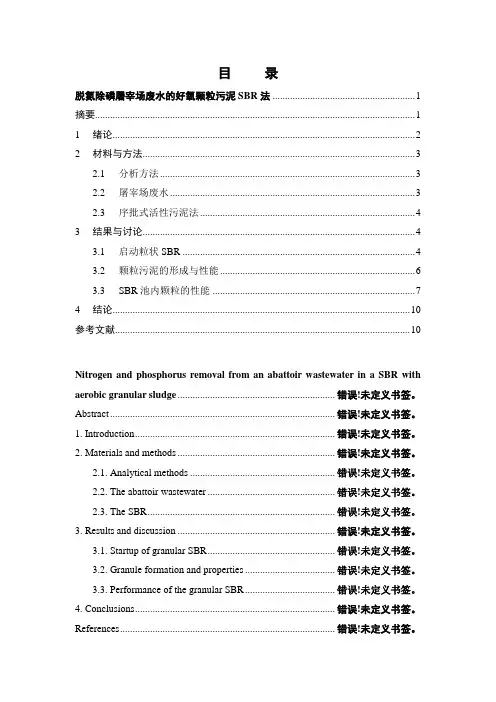
目录脱氮除磷屠宰场废水的好氧颗粒污泥SBR法 (1)摘要 (1)1绪论 (2)2材料与方法 (3)2.1分析方法 (3)2.2屠宰场废水 (3)2.3序批式活性污泥法 (4)3结果与讨论 (4)3.1启动粒状SBR (4)3.2颗粒污泥的形成与性能 (6)3.3SBR池内颗粒的性能 (7)4结论 (10)参考文献 (10)Nitrogen and phosphorus removal from an abattoir wastewater in a SBR with aerobic granular sludge............................................................. 错误!未定义书签。
Abstract ........................................................................................ 错误!未定义书签。
1. Introduction .............................................................................. 错误!未定义书签。
2. Materials and methods ............................................................. 错误!未定义书签。
2.1. Analytical methods ........................................................ 错误!未定义书签。
2.2. The abattoir wastewater ................................................. 错误!未定义书签。
《SBR工艺的应用现状与发展趋势探讨》篇一一、引言随着环保意识的日益增强和污水处理需求的不断增长,污水处理技术日益受到重视。
SBR(Sequencing Batch Reactor,序批式活性污泥法)工艺作为现代污水处理技术的一种,因其高效、灵活、低能耗等优点,得到了广泛应用。
本文将就SBR工艺的应用现状及其发展趋势进行探讨。
二、SBR工艺简介SBR工艺是一种按间歇方式运行的活性污泥污水处理技术。
它通过周期性的运行过程,包括进水、反应、沉淀、排水和闲置等阶段,实现对污水的处理。
该工艺能够适应不同的污水处理需求,处理效果好,污泥产量低,能很好地适应高浓度、难处理的工业废水处理。
三、SBR工艺的应用现状(一)应用领域SBR工艺在国内外广泛应用,主要应用于市政污水处理、工业废水处理和污水处理厂等领域。
特别是在一些小型或中型的污水处理项目中,SBR工艺因其灵活性高、运行成本低等优点而受到青睐。
(二)应用特点SBR工艺的应用特点主要表现在以下几个方面:一是处理效果好,能够达到较高的排放标准;二是运行灵活,可以根据实际需求调整运行参数;三是能耗低,降低了运行成本;四是设备简单,维护方便。
四、SBR工艺的发展趋势(一)技术创新随着科技的不断进步,SBR工艺的技术创新主要体现在以下几个方面:一是优化运行控制策略,提高处理效率;二是改进设备设计,降低能耗和成本;三是加强与其他技术的结合,如与物联网、大数据等技术的结合,实现智能化、自动化运行。
(二)智能化发展随着人工智能、物联网等技术的发展,SBR工艺的智能化发展已成为趋势。
通过引入智能化技术,可以实现SBR工艺的自动化控制、远程监控和数据分析等功能,进一步提高处理效率和降低运行成本。
(三)组合工艺发展为了提高处理效果和适应不同的污水处理需求,SBR工艺将更多地与其他工艺进行组合。
例如,与人工湿地、生态滤池等工艺进行组合,形成组合工艺系统,以实现更好的处理效果和资源回收利用。
SBR工艺的现状与发展(1)序批式间歇活性污泥法(SBR)是近年来应用日趋广泛的一种污水处理工艺,在SBR工艺的基础上,又发展了一些SBR的变型工艺,例如ICEAS工艺、CASS工艺、UNITANK工艺、ASBR工艺、BSBR工艺等.今后应加强SBR工艺中微生物的研究和可靠的工程设计模式的探讨。
关键词:序批式活性污泥法(SBR) 污水处理反应器Status Quo and Development of the Sequencing Batch ReactorAbstract:SBR(sequencing batch reactor)is a popular wastewater treatment process in recent years. Modified processes such as ICEAC,CASS,UNITANK,ASBR and BSBR have been developed on the basis of SBR.Some problems in the basic research and engineering design aspects should be noticed and settled to promote the applications of these wastewater treatment processes.Key words:sequencing batch reactor;wastewater treatment;tractor前言SBR是序批式间歇活性污泥法(SeguencingBatch Reactor)的简称。
它是近年来在国内外被引起广泛重视和研究日趋增多的一种污水生物处理新技术泪前已有一些生产性装置在运行之中。
我国是近10多年来才开始对SBR污水生物处理工艺进行研究的。
1985年,上海市政设计院为上海吴淞肉联厂设计投产了我国第一座SBR污水处理站,设计处理水量为2400t/d。
课程:给排水科学与工程毕业设计题目:SBR 法及其研究进展(文献)指导老师:吴慧英老师院系:土木工程学院专业:给排水科学与工程班级: 1 1 0 1班姓名:王东浩学号: 2 0 1 1 0 1 1 2 1 0 1日期:2015年5月31日SBR Method and progress of studyingT h e a r t i c l e c i t a t i o n s:d w a r d S.R u b i n,C l·i f f I.Davidson.Introduction to Engineering & the Environment.Beijing: t s i n g h u a u n i v e r s i t y p r e s s,2002.Summary: Have introduced the preface criticizing type i n t e r m i t t e n c e p r o d u c t i o n, development and characteristic of France of active mud (SBR), survey SBR is mixing speed DO, pH , between OPR and influence to deal with result , is it is it get rid of phosphorus mechanism and SBR and other craft deal with newest progress of sewage synthetically to nitrify instead to nitrify.Keyword: Criticizing type intermittence active mud law of the preface (SBR), Progress , ProspectThe process system of active mud , use the most extensive treatment technology in the field of sewage disposal at present. It is used in the sanitary sewage ,the treatment of municipal sewage and organism industrial sewage effectively, take measures to break through to traditional active mud technology only as second treatment technology tradition, can be as denitrification , tertiary treatment technology of getting rid of the phosphorus. SBR (sequencing batch reactor) law,namely preface criticize type intermittence active mud law, the active mud noticeable one activemud law to deal with new craft. It Japanese sewer association and American a few rich innovation meaning and strong waste water biological treatment technology one of of competitiveness that Environmental Protection Agency assess.1 characteristic and development1.1 Produce and developSBR craft has already been developed as far back as 1914, but because monitoring means lagged behind at that time, have not been popularized and applied . L.Irvine of U.S.A. carried on deep research to SBR craft in 1979, and Culver in Indiana state improved and put a SBR sewage treatment plant into operation in 1980. As too new-type to stop up the appearance which expose to the sun the angry device and software engineering that the computer controlled technology, various kindsof after this, is it dissolve oxygen measure apparatus , fluviograph high controlling economic water quality detection instrumenting to course precision online to develop at the same time, having managed and realized automation gradually in operation of the sewage treatment plant, in addition water quality ,craft are simple that SBR melts , dealing with the result steadily, shock-resistant load strength is strong, it is fine that water quality happens, operate flexible ,floor space advantage such as being little and become including U.S.A. , Germany ,Japan , Australia , adding ,etc. a lot of hot craft that industrially developed country research anddevelop competitively. Taking Australia as an example, it is up to nearly more than 600 to build up a sewage treatment plant which has adopted SBR craft in more than 10 years in the past.Middle period began the application study to SBR law in the 1980s i n o u r c o u n t r y. 1985, Shanghai Wusong meat is it is it is it stand to put our country into operation first SBR law sewage disposal to develop to unite, designing 2400t/ d of amount of water dealt with, the operation result is good. Already there are two large-and-middle-scale sewage treatment plants which adopt SBR craft in Kunming of Yunnan Province at present, it is in sound condition to run. The sewage treatment plant that Tianjin economic and technological development zone 100,000t/ d adopts SBR craft puts into operation recently too. According to studying the situation both at home and abroad, SBR law is a kind of high-efficient, economy, reliable waste water treatment method which is suitable for the national conditions of our country.1.2 Technological processMain reactor of the intermittence type active mud law, expose to the sun angry operation of pool it operates to be to flow into , react , precipitate , discharge and leave unused five processes not to make up. The sewage is according to the array in the reactor, enter each response process intermittently, each operation ,SBR of reactor operate at time arranging according to order thatintermittence run too.Before not flowing into process implement , leave unused process treated sewage already discharge, expose to the sun the remaining active mud and mixture of the high density in the angry pool. When the sewage is run into and flowed into ,exposing to the sun the angry pool can play a role in regulating the pool , is it expose to the sun angry to can is it expose to the sun angry result in advance to make , can make mud regeneration to go on, resume its activation.The response process is main a process of SBR craft . Is it is it book volume to reach as sewage , can is it is it operate to react to begin to inject into,such as get rid of BOD , nitrify , absorption of phosphorus, and nitrify etc. instead . According to reflecting the degree that the need reaches, it is angry that the trace of carrying on short time is exposed to the sun, in order to blowand take off the bubble or nitrogen seized on the mud , so as to ensure the mashed of arranging goes on smoothly.Arranging the mud process, it is angry and mix that stop exposing to the sun, make the mixture in static state, mud not active and moisture from, in other words two times precipitate by function of pool. After precipitating on if surfacing, discharge dealing with liquid conduct, stay during exposing to the sun pool not angry mud that precipitate as kinds of mud, play the function of the backset current mud .Leaving the process unused, after dealing with and surfacing and discharging, the reactor stays cool, wait for the next cycle of operation. During this period, it is angry in order to the corruption of avoiding the mud that should expose to the sun disconnectedly and slightly . The active mud left unused is in the hunger state of the nutrient, so as the inflow process of entering next operation cycle, the active mud can give play to stronger ability of absorbing to strengthen and get rid of function . It is an important content in SBR craft to leave the processunused.1.3 Craft characteristic and subject matterSBR craft compares with active mud law of the continuous type , have the following advantage:(1) The technological process are simple, do not need to set up two and sinking the pool and mud backset current equipment separately , can be saved and sunk the pool for the first time under most situations.(2) The floor space is small, the fabrication cost is low; Especially the sewage disposal constant ordinary active mud law of the small town saves more than 30% of capital expenditure .(3) The nutriment gets rid of the result and denitrification phosphorus effectually.(4) The mud subsides of good performancly.(5) Adaptability is good, and easy maintenance management. Thesubject matter that SBR law exists is: It is complicated to o p e r a t e,e x p e c t m u c h t o t h e a u t o m a t i c c o n t r o l;In addition own its technological process have determined the device utilization ratio of the equipment is low.2 studies progress2.1 Reactor DO expose to the sun the angry way2.1.1 Influence of DOReactor dissolve content of oxygen influence physiological activity of microorganism in the mud, thus influence the sewage d i s p o s a l p r o c e s s,s o D O c o n t e n t level in the reactor is worth probing into very much. Jeill OH and J.Silverstein , to SBR reactor, DO suppresses and nitrifies function and carries on research instead, dissolves the research range of oxygen from 0.09 mg/ L- 5.6 mg/ L in the sewage ;Find low density very dissolve oxygen can suppress to nitrify function instead active mud finally, DO =0.09 At the mg/ L , nitrify speed can from large speed 0.0214 mg-NOx-N/ mg-MLSS/ h drop 35% of speed their to most instead. But point out at the same time , act as DO =5.6 Can is it nitrify function instead to observe still at the mg/ L, and according to experiment, to nitrify model revise instead.2.1.2 Mix the influence of the speedSuch persons as Drigues , Jose Alberto Domingues ,etc. have carried on research in mixing the way of inflating to mix, theydeal with COD as the synthetic municipal sewage of 500 mg/ l by containing the particle mud reactor, dealing with cycle as 8 hours, handling capacity is 2.0 L. Mix research range of speed from 0 rev./ min~75rev./ min , find to get rid of rate 80~88 COD finally; Can get relatively good mud the time of staying in 50 rev./ min , does not destroy the particle and mud at the same time ; And use and mix the effective circulation that can increase the reactor to make total circulation time shorten. Experience equation and first class response dynamics model that they pointed out the remaining organic matter can be used for predicting that mix the impact on reactor of the speed.2.2 The mud expandsPerformance is good that the normal active mud subsides, the moisture content , about 99%, when the mud goes bad, the mud is difficult to precipitate, SVI value increases, mud is loosely organized and volume expansion, the moisture content rises, clarify the liquid rarly, the color changes differently, this has produced mud and expanded . Mud expands about 95% of problem relates to excessive hyperplasia of the silk form mushroom in water treatment, it is silk form fungus that is it combine water content gather high viscidity that thing causes expand more outside the high afterbirth generally to expand. SBR value generally relatively low SVI have, difficult to present question of expanding, can prevent from either sometimes.ShuYing Wang people utilize petrochemical industry waste w a t e r s t u d y s i l k f o r m fungus expand relation in organic load among the reactor in SBR, point out when dissolve oxygen (DO) sufficiently in the reactor , low organic load is apt to cause the mud to expand , improve the control that organic load can be effective and expand ; Under the high load , cause reason that mud expand often i n s u f f i c i e n t D O,i m p r o v e DO density can make mud is it control to expand, this result has e x p l a i n e d t o o t h e essence reason why the mud expands happens in high organic load.ChunDi Gao ,etc. utilize beer waste water study nitrogen lack cause silk form fungus expand the problem, find the density of different organic matter and terms of ratio(counts with BOD/ N) of the total nitrogen are influential for active mud to expand in entering water, point out that is entering water BOD/ N =100/ Under4 conditions, the performance of subsiding of the mud is good, entering water BOD/N =100/ 3 and BOD/ N =100/ One o'clock, take place by to fungus glue group excessive to grow cause that silk form mushroom expand viscidity have high moisture content, entering water BOD/ N =100/ Under 0.94 conditions, it is the most serious that it was not silk form mushroom that took place to expand.2.3 pH、ORPThe physiological activity of the microorganism and sour alkali degree (the density of hydrogen and ion) of the environment are closely related with, the density of hydrogen and ion can influence the electric charge nature on the membrane of microorganism's cytoplasm . Electric charge nature changes, microorganism's cell's function of absorbing the nutriment will change too, thus exert a bad influence on the physiological activity of the microorganism .Gao JingFeng ,etc. that the person nitrified in order to realize SBR law instead control onlinly and fuzzily , such change characteristics while the organic matter gets rid of and nitrifies , nitrify instead as research pH and ORP ,etc.. The change of pH draws : (1) While the organic matter gets rid of, pH presents the phenomenon(2) of rising by a wide margin when the organic matter gets rid of finishing , pH stopped rising, the ones that nitrified and reacted were dropping to and reflecting that is over constantly pH at the same time, and then pH suddenly rose or remained u n c h a n g e d f a s t.(3) In the course of nitrifying instead, pH is rising until nitrifying and finishing presenting turning point instead constantly, then drop continuously , point out and nitrify instead and has already been over. To ORP, carry on ORP is it is it drop to moderate to show as with nitrify instead, unexpected decreasespeed while nitrifying finishing instead increase appear the flex point.In a word, no matter which kind of carbon source does it use and is it invest with carbon source way and how prove PH and ORP have characteristic is it appear to order while nitrifying finishing instead quantity to admit, can judge through difference of speed that pH rise carbon source sufficient , adjust and controlc a r b o n s o u r c e t h r o w a nd a d d i n g.2.4 Study on nitrify , nitrify instead and dephosphorization 2.4.1 Getting rid of the result and operation condition of the nitrogen , phosphorusNitrogen one important index, water of pollution control, SBR law can degradation situation , bottom of thing change time of reacting in a flexible way according to reactor, thus realize it with oxygen with meagre oxygen , good of the pool conveniently, the biological denitrification result is good. JianHui Sun ,etc. adopt with meagre oxygen / good craft, SBR of oxygen, to carry on research with inferior ammonium law denitrification , papermaking of waste water. The ones that found SRT , NH3- N influenced total nitrogen were got rid of, and CODcr density is 1200~1800 mg/ L as entering the water, NH3- N density is 135~ 200 mg/ L, whether Nox-N density to at the 7~10 mg/ L , propose best to operate terms. It is the with meagre oxygen, fine than for1:1 of oxygen time.5,one cycle for 8 h; As without and the carbonsource, to get rid of rate 66% , throw second of adding after the sour sodium total nitrogen, to get rid of rate can rise to 85% total nitrogen.Reactor mud particle get rid of phosphorus characteristic receive waste water water quality , operation parameter and environmental factor ,etc. influence generally. Lu RanChao , etc. find through the experiment :(1) Sewage higher C/ N than or than with lower mud get rid of phosphorus to be favorable to living beings age in COD/ TN. (2) Enter the water proper nitrogen content or TN/ TP than is it get rid of phosphorus result and main factor , mud of particle to influence.(3) Shorter mud is favorable to getting rid of phosphorus function age , the too short difficult denitrification effectively of age of mud .(4) Temperature is reduced, having nitrifying function sourly and instead and is suppressed of the fermented mushroom, the nitrate is dense in the reactor, influence the reactor to get rid of phosphorus ability, get rid of phosphorus efficiency to drop. But he other operation parameter to fine oxygen forming of particle , for example dissolve oxygen , pH value , detest good oxygen replace time ,etc. correctly, have not studied further .2.4.2 Mud age (biological solid average the time of staying)The mud is pointed and exposed to the sun the active mud totalamount and proportion of amount of mud discharged of every day in the angry pool age . Namely active average the time of staying in exposing to the sun angry pool such as mud, because their call biological average the time of staying such as solid also. The mud is the process system of active mud age to design the important parameter operated, there are important meanings too in theory.Kargi people study different the time of staying (whether Kargi people study different the time of staying (whether from one day, divide 6 stages into), the reactor opposes and gets rid of the result to various kinds of nutriment, thus fixed mud the time of staying to COD, nitrogen and phosphate , nitrogen of ammonia and attitude of nitre get rid of result and best age such as mud for can reach most heavy COD , ammonia nitrogen , result of getting rid of of phosphate while being about one day, include: 94%, 84%, 70%. Find it is 10 weather age in the mud at the same time , SVI value is minimum .2.4.3 Study on carbon sourceSome report as the glucose is regarded as the only carbon source , the living beings can't be finished while getting rid of phosphorus function , reason detest oxygen without straight phosphate release under the terms, but advantage bacterial can accumulate large phosphate and absorb the glucose . But Jeon, Che Ok and Park, Jong Moon, through throwing in the glucose with 13C mark in the course of experiment, analyse with the nuclearmagnetic resonance (spectrum) the track of showing finds , even when the grape is regarded as the only carbon source , the living beings get rid of phosphorus function and follow the mechanism completely different from reporting at present; In two kinds of fungus group at least: Producing the lactic acid fungus and the function of gathering the phosphorus fungus can be finished. With the consumption of the glucose in this course, the glycogen quality is accumulated rapidly. But release of the straight phosphate and the relating to density of the total organic carbon b u t c o r r e l a t e w i t h d e n s i t y o f t h e g l u c o s e s synthetically of PHAs. The phosphate is released and proportional to pH value. Quantity that the quantity of formating PHAs should be smaller than the glucose to increase, because glucose produce LPO lactic acid fungus turn into other storage material (might for lactic acid particle) is it gather. At the stage with meager oxygen, but also the absorbing of phosphate takes place by the supersession in the materials of PHAs and storage in the cell. Among SBR, glucose as only carbon source, PHAs synthetic and phosphate it gets rid of to be possible supersession route.Louzeiro, Nuno R. Mavinic,etc. for while confirming using methyl alcohol as and carbon source of SBR reactor, have carried on a series of experiments to the influence of nitrifying the potentiality with the dephosphorization instead . They find: The ones that added methyl alcohol can observe two kinds nitrify thespeed instead ; The reaction speed slows down gradually afterwards very fast when being initial. The fast stage when initial nitrifies the speed to increase with increase of the density of the methyl alcohol instead ; With consumption of methyl alcohol , nitrify function sustain but speed slows down thereupon instead. At SBR it have only among reactor and methyl alcohol at being as carbon source for microorganism vs. the not absorbing and not releasing meaningful of phosphorus. Methyl alcohol might not use as carbon source is it raise living beings get rid of phosphorus function , but methyl alcohol it adds to be important to come, because it can consume the nitrate that can utilize , makes the living beings get rid of phosphorus function and go on.2.4.4 Study on electronic receptorLee, Dae Sung, Jeon, think density high inferior nitrate in 10 mgNO2/ L does not can suppress with meagre oxygen state phosphorus absorb. Moreover, they think phosphorus absorb speed to be fast comparing with the time when regard nitrate as the electronic receptor at regarding inferior nitrate as electronic receptoring also; Ahn, Johwan,etc. for is it is it gather supersession behavior , phosphorus of fungus to nitrify instead to study better, in is it have active intermittence preface of mud criticize type among the reactor to inoculate, have investigated the different kinds of absorbing to phosphorus under the condition with meager oxygen of electronic receptor concretly.They have studied three kinds of different electronic receptors: Nitric acid , inferior nitric acid and nitric acid mixed , inferior nitric acid, the result of the test verifies, regard nitric acid and inferior nitric acid as absorbing and having no inhibition to phosphorus under the condition with meagre oxygen of electronic receptor. Act as with meagre oxygen nitrogen amount produced to nitrify when equal toing , absorb quantity of phosphorus relative to take the light quantity while regarding nitrate as the electronic receptor at regarding inferior nitrate as electronic receptoring instead Under the condition with meagre oxygen, so long as there are electronic receptors to exist, the absorbing of phosphorus will happen , the absorbing of phosphorus when being with meagre oxygen has something to do with the load and type of the electronic receptor when being initial , in addition relate to MLSS which is short of oxygen state mud , when MLSS increases, the ability of absorbing of the phosphorus is shown as and dropped.2.5 With the association application of other water treatment technologySBR craft still belongs to developing sewage treatment technology, in the organic waste water treatment of the high density, adopt sometimes difficult to make the ideal result , combine with other crafts and often bring notable results on the basis of basic SBR craft directly. Whether appear in the newspapers to odd kinds as follows dish at home.ABR - -SBR: ABR one detesting oxygen roll over board shed the reactor , it has the characteristics that do not flow , not stop up , need to mix , apt to start short new-type,can hydrolysis control its acid take stage and SBR is it spend to unite , result good. Zhongshan treasure full of fragrant food seasoning Co., Ltd. one with producing soy sauce seasoning food enterprise, the waste water discharged in workshop is high in density, water quality is complicated, the fluctuating range of the density is large, difficult to belong to to degrade the pollutant. After adopting the association taking ABR-SBR as subject to deal with the craft , deal with and surface the first class standard that the index can reach GB 8978- 199 .UASB - -SBR - The ceramsite filters the craft: UASB promotes the flowing type abbreviation of detesting oxygen mud bed reactor. UASB reactor deals with the craft and has higher handling capacity and deals with efficiency, especially suitable for the treatment of the organic waste water of various kinds of high density, the ceramsite strains a quality lightly, the surface area is large, enough mechanical intensity , flood peak are lost littly , absorbs strength strongly, relatively the activated carbon is cheap at the price, it is dealt with that suitable for decolouring etc.. Li learn flat to use law this deal with Hunan some white spirit waste water of factory, sewage can reach comprehensive discharge s t a n d a r d G B8978-199s e c o n d s t a n d a r d.The concave air of CAF whirlpool floats - -SBR: CFA is it fasten hooliganism float device , by angry to float trough water purification machine make up , mix in order to the dreg blowing machine and produce such auxiliary equipment as the dreg machine ,etc. mainly to suck by oneself, the waste water treatment result of high content to the suspended substance is obvious. Domestic peaceful equal people apply it and SBR Kunming city live pig food trade market is it is it butcher treatment of waste water to deal with to come jointly, CODCr , SS of it, moving vegetable oil of, TP , TN , colour /get rid of time ,etc. there aren't rate: 94.49%, 98.89%, 99.77%, 99.45%, 60.91%, 93.75%, the result is obvious.Mix and congeal and float angrily - -A little electrolytic - -SBR craft: The a little electrolytic water purifier , to the change of the water quality of the waste water, especially the change of the dyestuffs kind has stronger adaptability , can cut down the density of pollutant further , ensure the steady operation of craft unit SBR; In addition it utilizes to be a little electrolytic pool principle, through electric water purifier spontaneous electrochemistry that produce is it reduce to oxidize, electricity is it collect , absorb , flocculate comprehensive function of precipitating etc. to enclose a little, it improve waste water can biochemistry, decolourization more result not more remarkable. Lin Liu , Yong Cui is it apply printing ink withbind craft this pharmaceutical mix treatment of waste water to live, COD Cr , SS , colour / time every get rid of rate up to 97.4% ~ 98.3% ~98.0% separately , a treated one surface every index reach design standard, the result is good.3 SBR craft prospectRelatively traditional active mud law, SBR craft is a kind o f n e w-t y p e t e c h n o l o g y that still needs to develop , improving constantly, whether working technique its enough for science still, operation experience of management owe ripe also, is it further investigate following odd problem to need.(1) The reactor operate of the cycle respectively microorganism's activation and population are distributed of the the active mud , and the supersession theory of the microorganism ;(2) Biological denitrification , getting rid of the further further investigation of the microbial mechanism of the phosphorus;(3) SBR operates the sureness of the parameter;(4) The unions of SBR and other treatment crafts use and deal with and include the high density poisonous harmful substance i n d u s t r i a l s e w a g e;SBR craft one high-efficient sewage disposal method, but time when staying in mud at present , fill water time these operate accurate choice of parameter compared with response time ,etc.,and how about adopt reasonable exposing to the sun the angry way , exposing to the sun the angry intensity, confirm appropriate filling water time and response time, well realize oxygen in the same reactor - -With meager oxygen - -Detest transition person who operate a series of question , oxygen of state , remain at competence , experience of fetching value, need to do a large amount of relevant research work. It is believed that as what has b e e n s t u d i e d a b o u t S B R c r a f t g o e s o n t h o r o u g h l y .SBR 法及其研究进展文章出处:作者dward S.Rubin,Cliff I.Davidson.《工程概论和环境》。